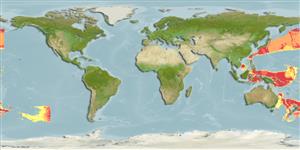>
Lophiiformes (Anglerfishes) >
Oneirodidae (Dreamers)
Etymology: Chirophryne: Greek, 'cheir' = hand + Greek, 'phryne' = toad; referring to its elongate pectoral-fin lobe..
More on authors: Regan & Trewavas.
Environment: milieu / climate zone / depth range / distribution range
Ecologie
marien bathypelagisch; diepte 1230 - 1400 m (Ref. 86949). Deep-water
Western Pacific: Papua New Guinea, Philippines and Japan.
Grootte / Gewicht / Leeftijd
Maturity: Lm ? range ? - ? cm
Korte beschrijving
Determinatiesleutels | Morfologie | Morfometrie
Dorsale zachte stralen (totaal) : 5 - 6; Anale zachte stralen: 4. Metamorphosed females distinguished by the following characteristics: presence of vomerine teeth; short frontals, lying posterior to the ethmoid region, convex dorsal margin; extremely well developed sphenotic spines; small symphysial spine on lower jaw; hyomandibula with double head; extremely well developed quadrate spine, four to nearly six times longer than articular spine; deeply notched posterior margin of opercle; short and broad subopercle, dorsal end rounded, ventral end oval in shape; well developed second pharyngobranchial; caudal fin rays without internal pigmentation; illicium longer than length of esca bulb; pterygoiphore of illicium cylindrical throughout its length, emerging on snout from between frontal bones, anterior end slightly exposed, posterior end concealed beneath skin; well developed first ray of dorsal fin; dorsal fin rays 5-6; anal fin rays 4; long and narrow pectoral fin lobe, longer than longest rays of pectoral fin; pectoral fin rays 18-19; skin without dermal spinules; darkly pigmented skin of caudal peduncle extends well past base of caudal fin (Ref. 86949).
Levenscyclus en paargedrag
Maturities | Voortplanting | Spawnings | Egg(s) | Fecundities | Larven
Kailola, P.J., 1991. The fishes of Papua New Guinea: a revised and annotated checklist. Vol. III. Gobiidae to Molidae. Research Bulletin No. 41, Research Section, Dept. of Fisheries and Marine Resources, Papua New Guinea. 153 p. (Ref. 6771)
Status op de Rode Lijst van het IUCN (Ref. 130435)
Can't connect to MySQL database (fbapp). Errorcode: Too many connections
